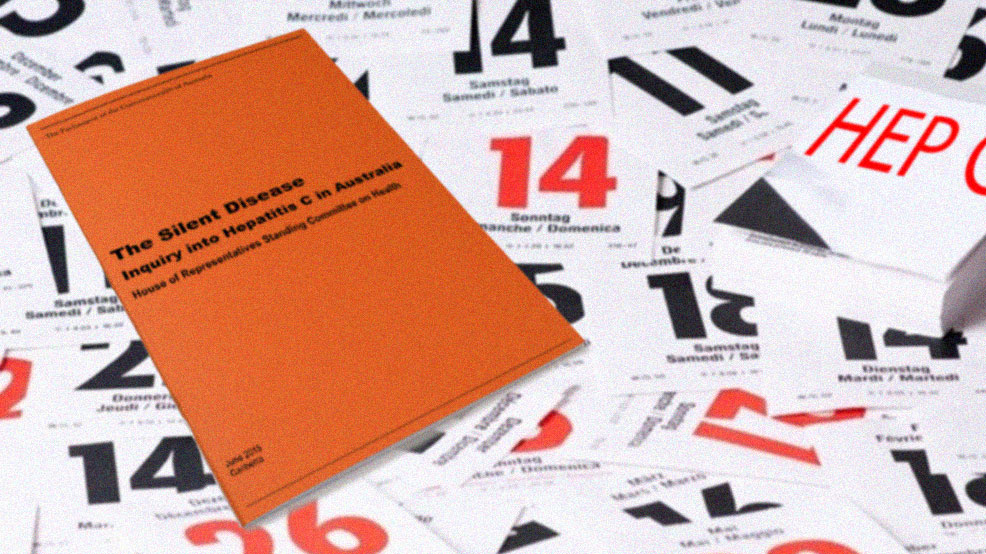The Federal Government’s response to the ‘Silent Disease’ inquiry into hepatitis C in Australia falls well short of what anyone living with hepatitis C could have hoped. Coming nearly 18 months after the report was submitted, the response fully accepted only three out of ten of the recommendations.
The Silent Disease Report was a comprehensive study from the House of Representatives Standing Committee on Health, and can be read online here. It made 10 main recommendations about the way the Australian Government should respond to the ongoing epidemic.
- The Department of Health should enhance reporting on the National Hepatitis C Strategy.
- The Australian Government, in collaboration with the states and territories, should work to develop well-informed hepatitis C awareness campaigns targeted at the general community, populations at high-risk of hepatitis C infection, people living with hepatitis C who have not sought advice about treatment options since their initial diagnosis, and the wider community (to highlight the impact of stigma on the social and emotional well-being of people living with hepatitis C and their families).
- The Department of Health, in consultation with relevant stakeholders, must devise a specific target or targets for hepatitis C testing and report on progress towards reaching the target or targets annually.
- The Department of Health should consider the ways in which rapid point of care testing (RPOCT) can assist in implementing the goals of the Fourth National Hepatitis C Strategy and the National Hepatitis C Testing Policy.
- The Department of Health should work with the Royal Australian College of General Practitioners and liver clinics to examine appropriate information provision, treatment processes, and patient counselling for people diagnosed with hepatitis C.
- The Department of Health must work with States and Territories to produce culturally and linguistically specific information for migrant groups with higher rates of hepatitis C infection to inform them about hepatitis C including: transmission methods, testing and treatment options.
- The Department of Health should work with States and Territories to develop strategies to address the high prevalence rates of hepatitis C in the Aboriginal and Torres Strait Islander population.
- The Department of Health must work with State and Territory health and corrections agencies to develop a standard approach to data collection and reporting of prisoner health in custodial settings, and give consideration to the provision of support for safe tattooing, barbering and any other legal practices which may present a risk of hepatitis C transmission in custodial settings.
- A national strategy for blood-borne viruses and sexually transmissible infections in prisons must be developed.
- The Australian Government should raise the issue of hepatitis C in prisons, and the establishment of national standards in prison health delivery as part of the Council of Australian Governments (COAG) Health Council process.
(Interestingly, the main way in which the Silent Disease report itself fell short, in failing to recommend easy access to new direct-acting antiviral (DAA) medication for hepatitis C, has been overtaken by events. In 2016 a number of DAAs were made available on the PBS, and are performing extremely well: more than 90 per cent of people who complete treatment are now free of their hepatitis C.)
Three out of Ten
In its long-awaited response, the Federal Government has fully agreed with only three of these ten recommendations (numbers 1, 6 and 7), though it claims that funding has been provided to support several more. Several recommendations are merely ‘noted’ in the governmental response.

Disappointingly, The Government has ruled out a national hepatitis C awareness campaign, saying “To change the wider community’s beliefs and attitudes around hepatitis C will only result from a long-term ongoing discussion within the community as a whole. Community leaders (including political and cultural leaders) will be pivotal in engaging with the wider community on these issues.” This may be true, but the Australian community has a vast number of issues to consider at any one time. Without an awareness campaign to provide information and prompt reflection, it is likely that serious discussion of hepatitis C will not be heard above the noise.
The Government has agreed, in principle, that standardised data collection in prisons is valuable, and it will engage with the Australian Institute of Health and Welfare for future versions of the ‘Health of Australia’s Prisoners’ report. However, the Government has not agreed to recommendations for a National Strategy for blood-borne viruses in Australian prisons. They have instead stated that any action on hepatitis C in prisons is the responsibility of the various State Governments.
The Australian Government’s statement is that “[We are] willing to work with states and territories on [hepatitis C in prisons] if they wish to raise it as part of the COAG Health Council process.” This characteristic unwillingness on the part of the Federal government to take the lead on an important issue means that all state hepatitis organisations, like Hepatitis SA, must keep up the pressure on their State governments to bring the matter up for discussion.
You can read the Australian Government’s responses to the report here. [Note: This report is no longer available online, but you can view the report on the enquiry tabled to Parliament in 2015.]
Last updated 10 April 2025
More from:
Enjoyed this article? Subscribe to be notified whenever we publish new stories.
Subscribe for Updates





